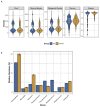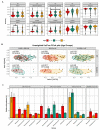The Lung Microbiome in Young Children with Cystic Fibrosis: A Prospective Cohort Study
- PMID: 33652802
- PMCID: PMC7996874
- DOI: 10.3390/microorganisms9030492
The Lung Microbiome in Young Children with Cystic Fibrosis: A Prospective Cohort Study
Abstract
The cystic fibrosis (CF) lung harbours a diverse microbiome and reduced diversity in the CF lung has been associated with advancing age, increased inflammation and poorer lung function. Data suggest that the window for intervention is early in CF, yet there is a paucity of studies on the lung microbiome in children with CF. The objective of this study was to thoroughly characterise the lower airway microbiome in pre-school children with CF. Bronchoalveolar lavage (BAL) samples were collected annually from children attending the three clinical centres. Clinical and demographic data were collated on all subjects alongside BAL inflammatory markers. 16S rRNA gene sequencing was performed on the Illumina MiSeq platform. Bioinformatics and data analysis were performed using Qiime and R project software. Data on 292 sequenced BALs from 101 children with CF and 51 without CF show the CF lung microbiome, while broadly similar to that in non-CF children, is distinct. Alpha diversity between the two cohorts was indistinguishable at this early age. The CF diagnosis explained only 1.1% of the variation between the cohort microbiomes. However, several key genera were significantly differentially abundant between the groups. While the non-CF lung microbiome diversity increased with age, diversity reduced in CF with age. Pseudomonas and Staphylococcus were more abundant with age, while genera such as Streptococcus, Porphyromonas and Veillonella were less abundant with age. There was a negative correlation between alpha diversity and interleukin-8 and neutrophil elastase in the CF population. Neither current flucloxacillin or azithromycin prophylaxis, nor previous oral or IV antibiotic exposure, was correlated with microbiome diversity. Consecutive annual BAL samples over 5 years from a subgroup of children demonstrated diverse patterns of development in the first years of life.
Keywords: bronchoalveolar lavage; bronchoscopy; children; cystic fibrosis; infection; inflammation; lung; microbiome; microbiota; paediatrics.
Conflict of interest statement
The authors declare no conflict of interest.
Figures






Similar articles
-
Upper versus lower airway microbiome and metagenome in children with cystic fibrosis and their correlation with lung inflammation.PLoS One. 2019 Sep 19;14(9):e0222323. doi: 10.1371/journal.pone.0222323. eCollection 2019. PLoS One. 2019. PMID: 31536536 Free PMC article.
-
Association of Antibiotics, Airway Microbiome, and Inflammation in Infants with Cystic Fibrosis.Ann Am Thorac Soc. 2017 Oct;14(10):1548-1555. doi: 10.1513/AnnalsATS.201702-121OC. Ann Am Thorac Soc. 2017. PMID: 28708417 Free PMC article.
-
An integrated metaproteomics workflow for studying host-microbe dynamics in bronchoalveolar lavage samples applied to cystic fibrosis disease.mSystems. 2024 Jul 23;9(7):e0092923. doi: 10.1128/msystems.00929-23. Epub 2024 Jun 27. mSystems. 2024. PMID: 38934598 Free PMC article.
-
Is bronchoscopy an obsolete tool in cystic fibrosis? The role of bronchoscopy in cystic fibrosis and its clinical use.J Thorac Dis. 2017 Sep;9(Suppl 10):S1139-S1145. doi: 10.21037/jtd.2017.06.143. J Thorac Dis. 2017. PMID: 29214071 Free PMC article. Review.
-
Microbiome in the pathogenesis of cystic fibrosis and lung transplant-related disease.Transl Res. 2017 Jan;179:84-96. doi: 10.1016/j.trsl.2016.07.022. Epub 2016 Aug 4. Transl Res. 2017. PMID: 27559681 Review.
Cited by
-
Building RECOVERY: development of the registry of eating disorders and their co-morbidities OVER time in youth.J Eat Disord. 2024 Sep 27;12(1):147. doi: 10.1186/s40337-024-01097-7. J Eat Disord. 2024. PMID: 39334287 Free PMC article.
-
Comparison of the airway microbiota in children with chronic suppurative lung disease.BMJ Open Respir Res. 2021 Dec;8(1):e001106. doi: 10.1136/bmjresp-2021-001106. BMJ Open Respir Res. 2021. PMID: 34949574 Free PMC article.
-
Microbiome-Mucosal Immunity Nexus: Driving Forces in Respiratory Disease Progression.J Microbiol. 2024 Sep;62(9):709-725. doi: 10.1007/s12275-024-00167-4. Epub 2024 Sep 6. J Microbiol. 2024. PMID: 39240507 Review.
-
Quantification of Phenotypic Variability of Lung Disease in Children with Cystic Fibrosis.Genes (Basel). 2021 May 25;12(6):803. doi: 10.3390/genes12060803. Genes (Basel). 2021. PMID: 34070354 Free PMC article. Review.
-
Aspergillus fumigatus Supernatants Disrupt Bronchial Epithelial Monolayers: Potential Role for Enhanced Invasion in Cystic Fibrosis.J Fungi (Basel). 2023 Apr 19;9(4):490. doi: 10.3390/jof9040490. J Fungi (Basel). 2023. PMID: 37108944 Free PMC article.
References
-
- Fodor A.A., Klem E.R., Gilpin D.F., Elborn J.S., Boucher R.C., Tunney M.M., Wolfgang M.C. The adult cystic fibrosis airway microbiota is stable over time and infection type, and highly resilient to antibiotic treatment of exacerbations. PLoS ONE. 2012;7:e45001. doi: 10.1371/journal.pone.0045001. - DOI - PMC - PubMed
Grants and funding
LinkOut - more resources
Full Text Sources
Other Literature Sources

